Matthew Higgins and Thomas
Klitgaard
Current account
deficits in euro area periphery countries have now largely disappeared. This
represents a substantial adjustment. Only two years ago, deficits stood at nearly
10 percent of GDP in Greece and Portugal and 5 percent in Spain and Italy (see
chart below). This sharp narrowing means that spending has been brought in line
with income, largely righting an imbalance that had left these countries
dependent on heavy foreign borrowing. However, adjustment has come at a sizable
cost to growth, with lower domestic spending only partly offset by higher
export sales. Downward pressure on domestic spending should abate now that the
periphery countries have been weaned from foreign borrowing. The risk, though,
is that foreign creditors might demand that the countries pay down (rather than
merely service) accumulated external debts, forcing them to reduce spending
below incomes.
A country’s current account balance
measures how much it lends to or borrows from the rest of the world. A country where
imports run ahead of exports is also spending more than it produces and must
borrow abroad to make up the difference. Countries in the euro area periphery borrowed
heavily from abroad during the several years leading up to the ongoing sovereign
debt and banking crisis. As a result, they faced wrenching adjustment pressures
when foreign investors became unwilling to extend new credit, even with the
lure of sharply higher interest rates. These adjustment pressures forced
changes in the balance between exports and imports, and equivalently in the balance
between income and spending, without any help from an exchange rate channel because
of the shared euro currency.
Exports and Imports
The loss in access to foreign credit meant that export revenues had to rise
relative to import purchases. As seen in the table below, much of the recent
adjustment in Italy, Spain, and Portugal has come from higher export revenues. From
2010 to 2012, nominal goods and services exports in these countries rose by 15 percent or more, roughly in line with Germany’s performance. Higher exports in
these countries have helped support growth, softening ongoing economic
downturns. Greece, in contrast, saw export sales rise only 8 percent over this two-year
period; this increase provided only limited help easing the country’s severe
downturn.
A look at the geographic breakdown of
goods exports shows that the lion’s share of the increase was from sales
outside the euro area, particularly to markets in North America, Asia, and
oil-exporting countries. Indeed, periphery countries’ sales outside the euro area rose by roughly 30 percent over the two-year period, compared with growth of less than 10 percent for sales inside the euro area.
Discussions of external adjustment
in the periphery often stress the need to improve external competitiveness. Unfortunately,
competitiveness measures are at best imperfect. A common metric is based on
unit labor costs, that is, on labor compensation growth relative to labor
productivity. The intuition is simple:
Higher wages erode competitiveness unless offset by productivity gains. However,
this measure can be misleading in turbulent times. The shutdown of low-productivity
firms boosts the economy’s average productivity, but does not mean that
competitiveness has improved at surviving firms. Economy-wide unit labor cost
measures can be particularly misleading when downturns are concentrated in
low-productivity sectors such as construction. For example, much of the
measured decline in Spain’s unit labor costs over the past several years owes
to the country’s construction crash.
The Organisation for Economic
Co-operation and Development calculates a measure of competitiveness based on
export performance adjusted for the strength of trading partners’ economies. If
exports grow more rapidly than trading partners’ total imports do, a country
gains export market share; if exports grow more slowly, a country loses it.
By this metric, Spain and Portugal
have done well in recent years, with exports growing 6 to 8 percent faster than
trading partners’ total imports from 2010 to 2012. (These figures are based on
preliminary estimates from late 2012.) This matches up well with Germany’s performance
of exports, which grew 5 percent faster than trading partners’ total imports. Italian
exports, in contrast, just kept pace with imports in destination markets. Meanwhile,
Greece lost substantial market share, with exports growing 10 percent more
slowly than destination market imports did over the period.
Import weakness also contributed to the
external adjustment in the periphery. This was particularly true in Greece and
Portugal, where purchases of foreign goods and services dropped 11 percent and 4 percent, respectively, from 2010 to 2012. Italy’s imports rose modestly, while
Spain’s rose 6 percent. In all cases, import growth fell far short of export
growth, helping to reduce external borrowing.
Ongoing economic downturns have been
the key driver of import weakness in the periphery. Indeed, import spending
remains well below levels prevailing before the Great Recession; import
spending in Germany, in contrast, has moved well above it pre-recession level. One
concern is that periphery import spending might pick up quite strongly once economies
recover, bringing a new round of large current account deficits. A more positive
take is that the difficult adjustments have brought imports in line with
exports; going forward, the two can grow together without the need for new
borrowing.
Spending and Income
A current account deficit means that domestic spending is greater than
domestic income. An alternative but equivalent measure of this gap is the
difference between domestic investment and domestic saving. (Note that a
country’s public and private spending goes either to consumption or investment,
while income not spent on current consumption is by definition saved. Thus, the
gap between spending and income is equal to investment spending minus saving. This
same accounting logic means that a country’s fiscal deficit is the difference between
government saving and investment spending.) The table below shows that much of
the narrowing in periphery current account deficits over the past two years has
come from lower investment spending, with declines equal to almost 2 percentage
points of GDP to more than 4 percentage points. Higher saving also contributed
to reduced current account deficits, with small increases in Italy and Spain
and more substantial increases in Greece and Portugal.
The drop in investment spending,
particularly outside the housing sector, could limit improvement in periphery
competitiveness and growth prospects. As the next chart shows, this is
especially the case since the recent drop in investment comes on the heels of
an already large drop in 2008 and 2009—during the Great Recession but before
the euro area crisis took hold. In contrast, investment spending in Germany has
seen no pullback. Notably, economic recoveries are often led by investment
spending. One risk for the periphery, then, is that stronger growth could see
current account deficits widening as investment spending is again financed by
external borrowing. On the positive side, stronger growth would also help boost
public and private saving by limiting government budget deficits and raising corporate
profits.
Conclusion
Periphery countries have suffered painful
contractions weaning themselves from foreign borrowing. The hope now is that
the restoration of external balance in these countries will set the stage for
meaningful recoveries. The debt burden from past borrowing remains, however, and
argues for caution about the periphery outlook. Much will depend on the
behavior of external investors. A further pullback would force periphery
countries to lower spending below incomes to generate current account surpluses
to pay down (rather than merely service) accumulated external debts. This would
suggest an even steeper drop in periphery consumption and living standards. Recent
balance-of-payments data have been encouraging on that point, however, as
private investors stopped pulling money out of periphery countries in the
second half of 2012, apparently reassured by the European Central Bank’s Outright Monetary Transaction program that was announced last August.
Disclaimer
The views expressed in this post are those of the authors and do not necessarily reflect the position of the Federal Reserve Bank of New York or the Federal Reserve System. Any errors or omissions are the responsibility of the authors.

Matthew Higgins is a vice president in the Federal Reserve Bank of New York’s Emerging Markets and International Affairs Group.

Thomas Klitgaard is a vice president in the Bank’s Research and Statistics Group.










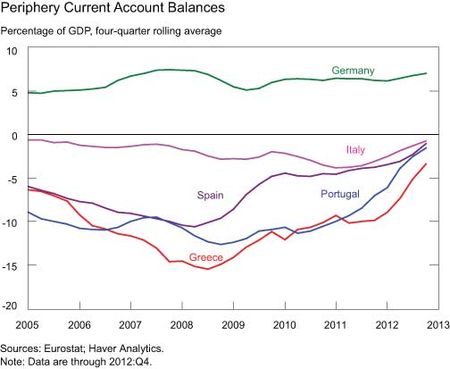
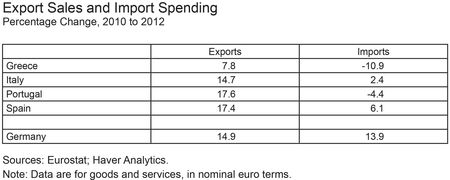
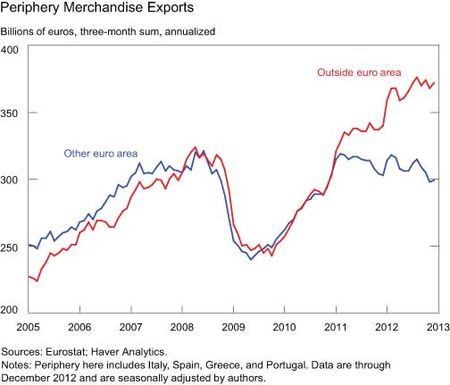
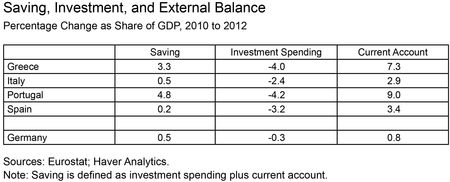
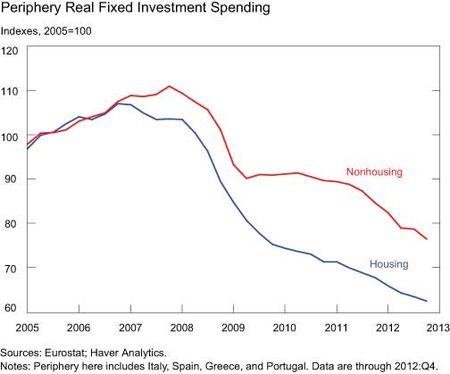
 RSS Feed
RSS Feed Follow Liberty Street Economics
Follow Liberty Street Economics
I believe it always comes down to Germany. Every other single EU country may “adjust” but unless Germany does as well the crisis will never be over. There are always two sides to an equation (and an acc. entity) and we can clearly see the Germans have not done their part during the adjustment process.They should spend more,save less,be tolerant for some inflation and realize that they will share the burden either way. Thank you very much for the article.